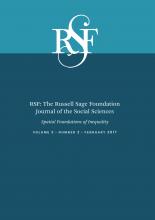Abstract
Residential segregation by income and education is increasing alongside slowly declining black-white segregation. Segregation in urban neighborhood residents’ nonhome activity spaces has not been explored. How integrated are the daily routines of people who live in the same neighborhood? Are people with different socioeconomic backgrounds that live near one another less likely to share routine activity locations than those of similar education or income? Do these patterns vary across the socioeconomic continuum or by neighborhood structure? The analyses draw on unique data from the Los Angeles Family and Neighborhood Survey that identify the location where residents engage in routine activities. Using multilevel p2 (network) models, we analyze pairs of households in the same neighborhood and examine whether the dyad combinations across three levels of SES conduct routine activities in the same location, and whether neighbor socioeconomic similarity in the co-location of routine activities is dependent on the level of neighborhood socioeconomic inequality and trust. Results indicate that, on average, increasing SES diminishes the likelihood of sharing activity locations with any SES group. This pattern is most pronounced in neighborhoods characterized by high levels of socioeconomic inequality. Neighborhood trust explains a nontrivial proportion of the inequality effect on the extent of routine activity sorting by SES. Thus stark, visible neighborhood-level inequality by SES may lead to enhanced effects of distrust on the willingness to share routines across class.
- © 2017 Russell Sage Foundation. Browning, Christopher R., Catherine A. Calder, Lauren J. Krivo, Anna L. Smith, and Bethany Boettner. 2017. “Socioeconomic Segregation of Activity Spaces in Urban Neighborhoods: Does Shared Residence Mean Shared Routines?” RSF: The Russell Sage Foundation Journal of the Social Sciences 3(2): 210–31. DOI: 10.7758/RSF.2017.3.2.09. The authors wish to thank Jonathan Dirlam, Ruth Peterson, Mei-Po Kwan, Yanan Jia, and Samuel Bussmann. This research was supported by the National Institute on Drug Abuse R01 DA032371 03 (“Adolescent Health and Development in Context”), the National Science Foundation DMS-1209161 (“Bayesian Methods for Socio-Spatial Point Patterns and Networks”), and the Ohio State University Institute for Population Research (NICHD P2CHD058484). Direct correspondence to: Christopher R. Browning at browning.90{at}osu.edu, Department of Sociology, The Ohio State University, 238 Townshend Hall, 1885 Neil Ave Mall, Columbus, OH 43210; Catherine A. Calder at calder{at}stat.osu.edu, Department of Statistics, The Ohio State University, 429 Cockins Hall, 1958 Neil Ave., Columbus, OH 43221; Lauren J. Krivo at lkrivo{at}sociology.rutgers.edu, Department of Sociology, Rutgers, The State University of New Jersey, 26 Nichol Avenue, New Brunswick, NJ 08901; Anna L. Smith at smith.11066{at}buckeyemail.osu.edu, Department of Statistics, The Ohio State University, 404 Cockins Hall, 1958 Neil Ave., Columbus, OH 43221; and Bethany Boettner at boettner.6{at}osu.edu, Institute for Population Research, The Ohio State University, 65 Townshend Hall, 1885 Neil Ave Mall, Columbus, OH 43210.
Open Access Policy: RSF: The Russell Sage Foundation Journal of the Social Sciences is an open access journal. This article is published under a Creative Commons Attribution-NonCommercial-NoDerivs 3.0 Unported License.






